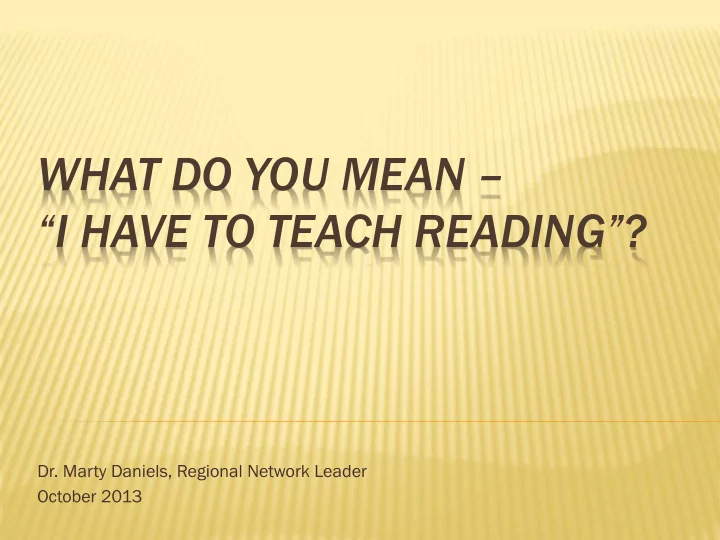

WHAT DO YOU MEAN – “I HAVE TO TEACH READING”? Dr. Marty Daniels, Regional Network Leader October 2013
WHY ‘LITERACY IN OTHER DISCIPLINES’? Ò Literacy is a shared responsibility “The Standards insist that instruction in reading, writing, speaking, listening, and language be a shared responsibility within the school.” Introduction to the CCSS, p. 4 Who should teach students how to read and understand content concepts?
WHY CHANGE? Ò SCHOOL IS NOT “THE SAME”. Ò Emphasis on multiple sources of information Ò Encourage mastery of concepts Ò Close precise study of primary sources Ò Blending of reading and experimenting/ doing Ò Digital natives who collaborate
Ò Students need to understand reading skills’ consistency and differences based on content. É What does the skill look like in science compared to ELA compared to computer science?
STANDARDS STRUCTURE Ò Anchor Standards Ò Literacy in Other Disciplines Standards directly connect but are content focused. Ò Critical reading and thinking are foundational skills needed.
Literacy Standards – a Closer View ANCHOR – CCR.3 Analyze how and why individuals, events, or ideas develop and interact over the course of the text. SS/History - G9 -10 Analyze in detail a series of events described in a text, determine whether earlier events caused later ones or simply preceded them. Sci/Tech G9-10 - Follow precisely a complex multistep procedure when carrying out experiments, taking measurements, or performing technical tasks, attending to special cases or exceptions defined in the text.
STAGE ONE: STUDENT ENGAGEMENT Ò Energy Ò The Need to Know Ò Building Background Ò Academic Vocabulary 9
CLASS ENERGY Eng ngageme ment nt i is N NOT e ent ntertainme nment nt – – i it i is mo moving ng a away y from t m the he f front nt o of t the he r room t m to o open t n the he c cla lass t to s student nt participation. n. Wha hat do students need to know? Wh Why do the students need to know?
BUILDING BACKGROUND Marzano – “What students already know about a topic is the one of the strongest indicators of how well they will learn new material.” É Assess through anticipation guides, carousel walks, discussion É Build through experience, virtual trips, picture books, additional reading
ACADEMIC VOCABULARY Ò Vocabulary IS the Content É 3 Tiers - Tier 2 – explicit instruction/Tier 3 text supported É Textbook determination may not be right É Specific vocabulary strategies - vary
READING IN THE CONTENT Ò Reading specialists help students with reading skills Ò Content Teachers show students HOW to use those skills to access concepts in the discipline É Writing of texts may be rude to the reader
CONTENT READING DIFFERENCES Susan Lenski: “ The focus of English teachers is on teaching students how to use literary devices to interpret complex fictional texts; mathematics teachers show students how to read texts with precision; science teachers demonstrate how to transform information from one form to another; and history teachers should show how to evaluate sources and analyze and evaluate evidence”. Journal of Adolescent and Adult Literacy (2011/2012, p.279)
CRITICAL READING SKILLS ARE PROGRESSIVE Ò Blo loom’s m’s R Revised T Taxono nomy y É Remembering É Understanding É Applying É Analyzing É Evaluating É Creating 13
READING SKILLS IN CONTENT Ò Patterns ns o of T Tho hought ht É Definition É Classification É Order/Sequence É Cause/Effect É Compare/Contrast É Problem/Solution É Listing/Enumeration É Mixed Patterns
Ò Ele leme ment nts o of A Argume ment nt É Parts of an Argument (issue, claim, support) É Fact, Informed Opinion, and Opinion É Author’s Purpose and Position É Examine evidence É Determine Viewpoint and Opposing Statements
READING STRATEGIES Ò Reading is about thinking and internalizing new information. Ò Strategies are intentional plans readers use to construct independent thought! Ò Caution - Textbook ‘kings’
WHEN AND HOW Ò Teach a strategy WHEN students will have opportunity to use it. É Strategy of the Week Ò Teach students HOW to use a strategy with explicit instruction, modeling, and practice. É Be content specific.
FIVE STRATEGIES – ANY CONTENT! Ò Making Connections Ò Asking Questions Ò Visualizing and Making Inferences Ò Determining What is Important Ò Summarizing and Synthesizing Harvey and Goudvis. Strategies that Work for Understanding and Engagement . (2007)
READING TO LEARN Ò BEFORE Reading - chapter walkthrough, visual emphasis, guest speaker, vocabulary, guide questions Ò DURING Reading – Active/passive readers, questioning, note-taking, discussion Ò AFTER Reading – Writing, research, sharing/ presenting
WHAT IF THEY STRUGGLE? Ò Complex texts are SUPPOSED to be hard. Ò Self-efficacy Ò Scaffold and Monitor Comprehension Strategies É Re-Read! É Read with someone É Slow down (or stop) to monitor understanding É Map understanding É Use text features to clarify Just b bec ecause s e studen ents a are h e having t trouble e rea eading t the e text xt d does esn’t ’t m mea ean t they c can’t ’t think a about the i e idea eas and c concep epts! 20
CREATING CONTENT WRITERS Ò Writing and Reading are Linked! É Analyze instead of Summarize É Encourage discovery/inquiry writing É Model with authors from the field É Allow student collaboration É Use digital writing É Emphasize content and understanding É Support rather than always evaluate
TEACHING READING - CHALLENGES Ò For Students É Sharing the Content Secrets É Unlocking Concepts and Ideas É Encouraging Deep Learning Ò For Teachers É Examining the content É Analyzing the concepts É Focusing for depth
Recommend
More recommend